AMD Radeon RX 590 Crossfire and the State of Multi-GPU Technology
Information technology always surprises united states how often we become requests for Crossfire and SLI benchmarks. Despite flatout telling readers not to invest in either applied science for years at present, there nevertheless seems to be quite a lot of involvement. It'southward even more surprising given AMD, and in particular Nvidia, have made no clandestine about the fact that they are pulling back on multi-GPU engineering.
On our end, we've been stubborn about it and for the by year we have basically refused to check information technology out. But recently two RX 590 cards came our way and we thought, why not?
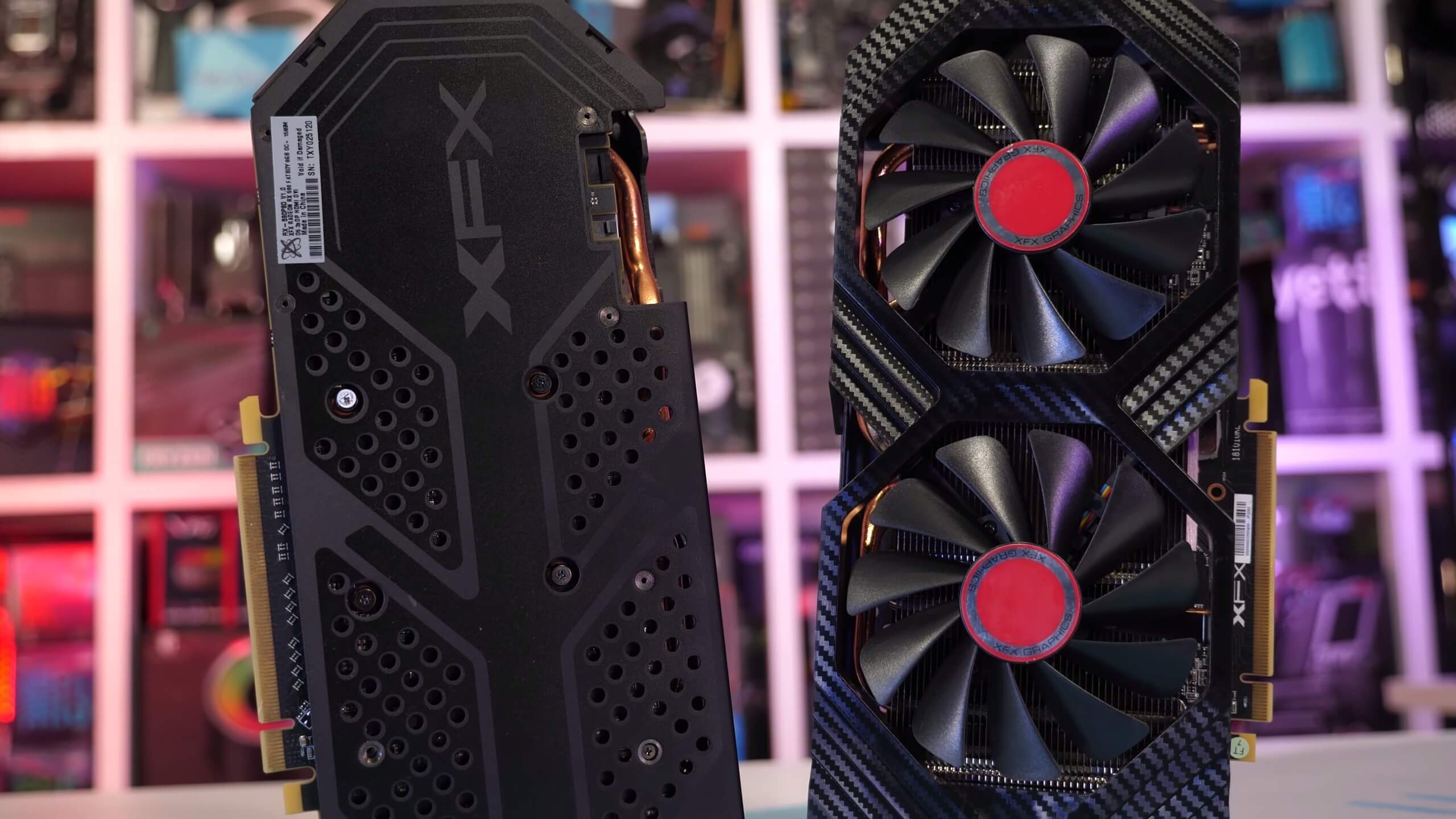
The last time nosotros ran a multi-GPU comparing at TechSpot was back in 2022 when we tested a GeForce GTX 980 Ti SLI configuration against Radeon R9 Fury 10 Crossfire. The Fury X cards came out on peak by a small four% margin across the ten games tested at 4K. Later that we constitute less reasons to do a comparison and we went in the pursuit of achieving playable frame rates at 4K.
Then we tested two GTX 1080s in SLI and later in 2022 we coupled two Titan X cards, which we called the ludicrous graphics test because the cost of the graphics cards alone was upwards of $2,400. Little did we know, GPU prices were going mad shortly thereafter.
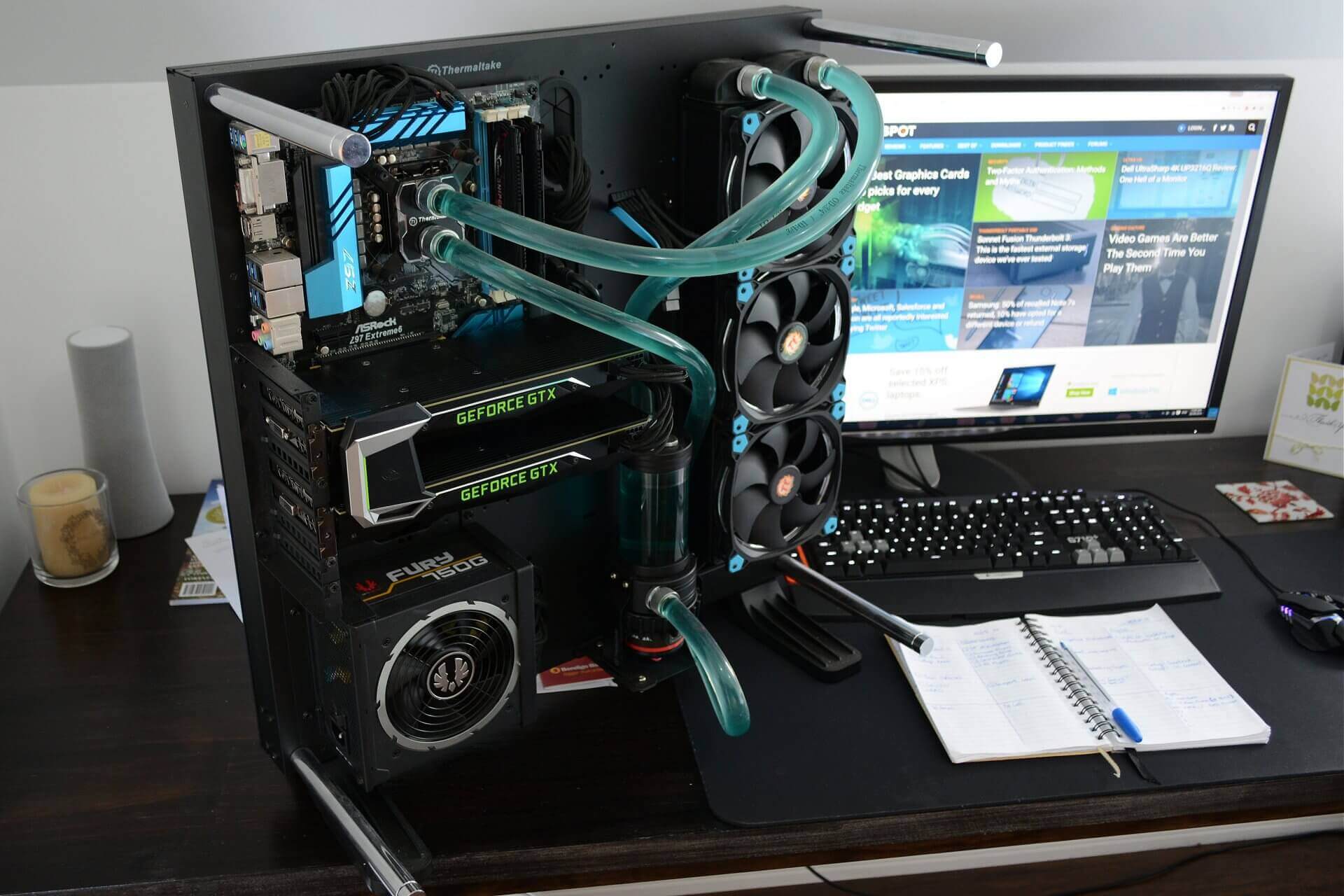
For today's test we have a dozen mod games and we're going to see how well two RX 590s compare to individual cards in 1080p and 1440p. For comparing nosotros have ix other graphics cards including high-end models such as Vega 64 and the RTX 2070. Our test bench system consists of a Cadre i7-8700K built within the Corsair Crystal 570X packing 16GB of DDR4-3400 memory.
Benchmarks
Battlefield V was the first title we tested and we're seeing no Crossfire in this title. No extra performance from the second card at 1080p, and the same is also true for the 1440p resolution.
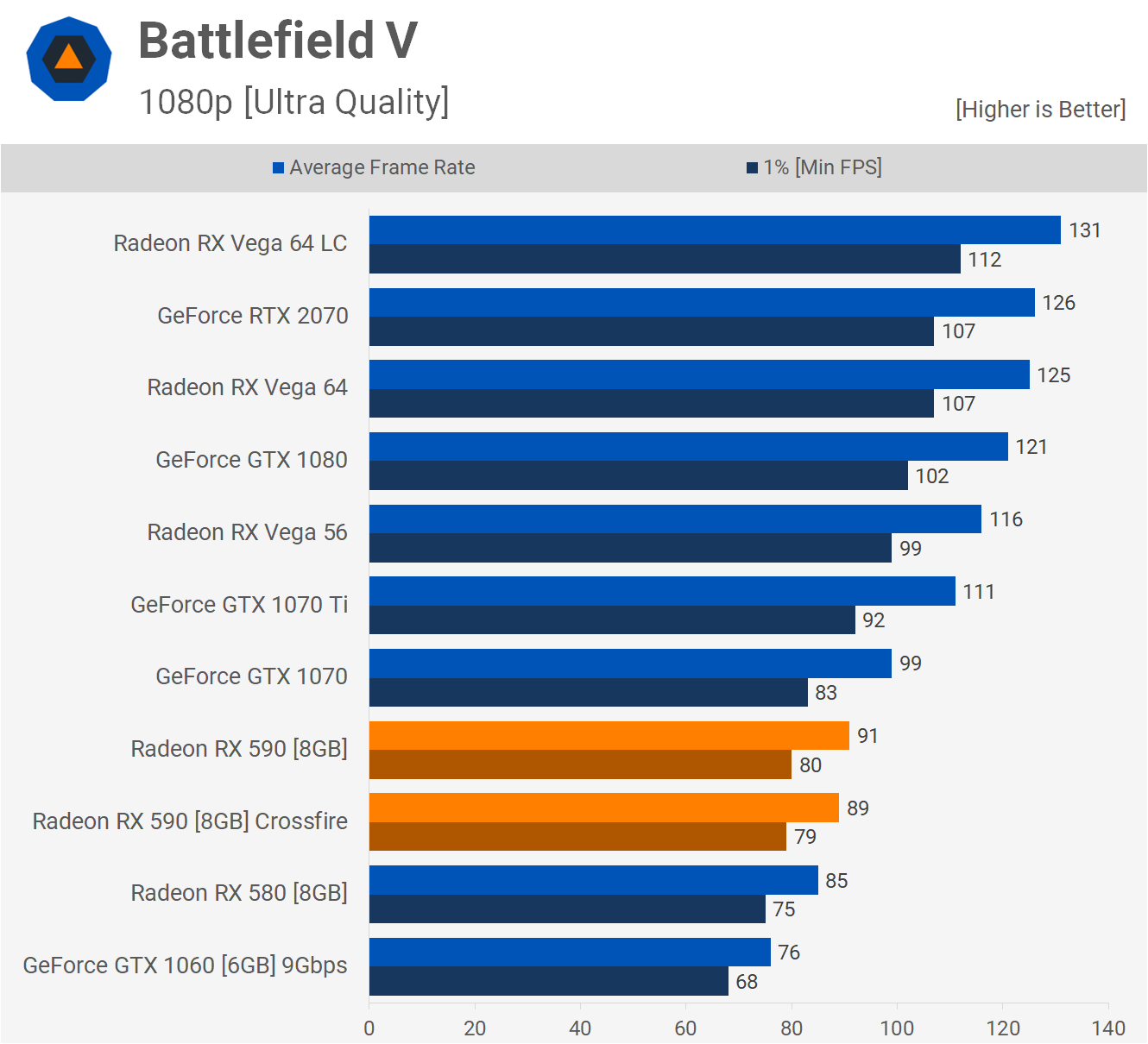
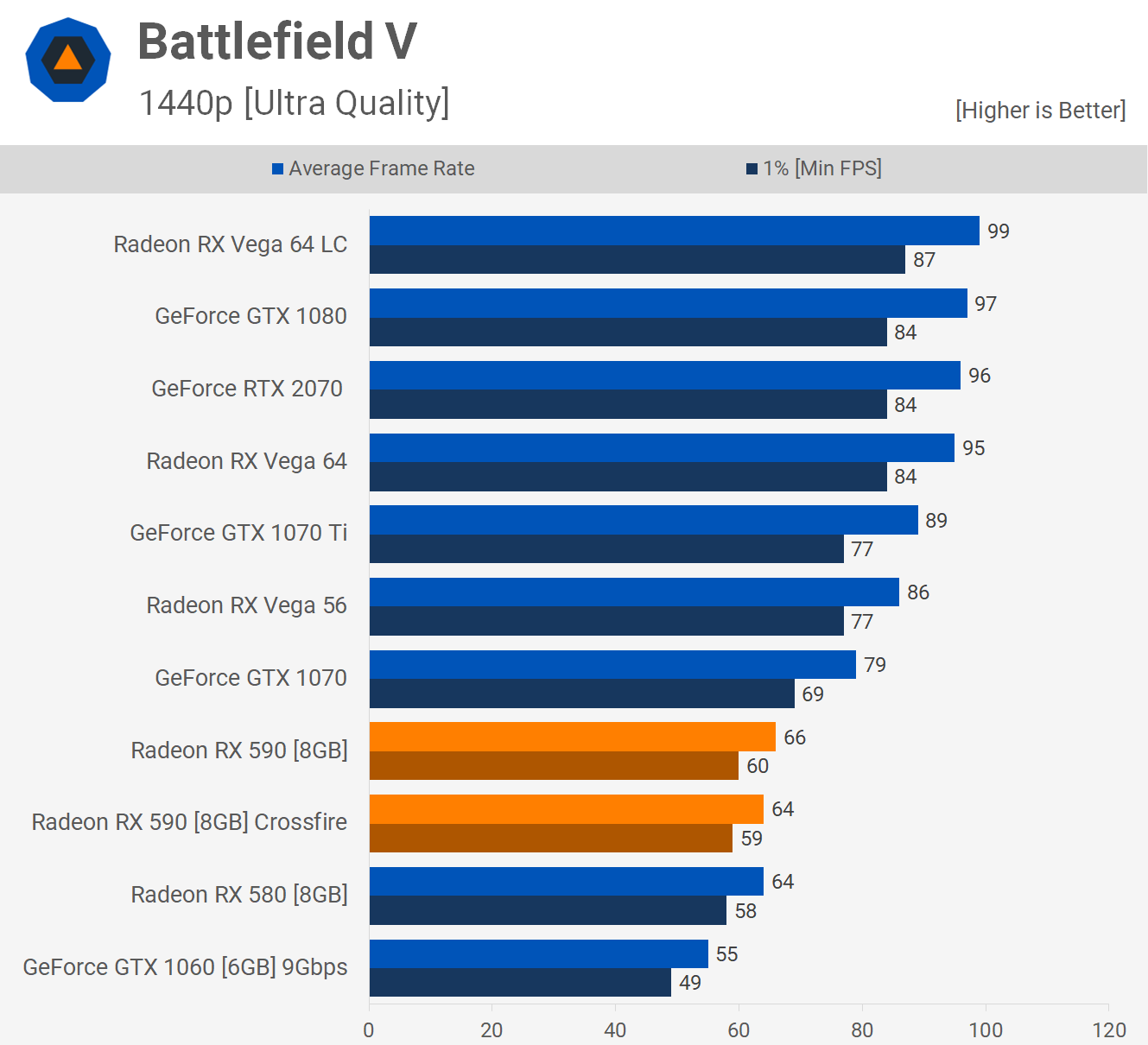
That was actually surprising as Crossfire worked in Battleground 1.
Here we encounter a 33% gain for the boilerplate frame charge per unit at 1080p. Not nifty just a big improvement over zilch, and scaling improves at 1440p where the RX 590s in Crossfire additional performance by 46%.

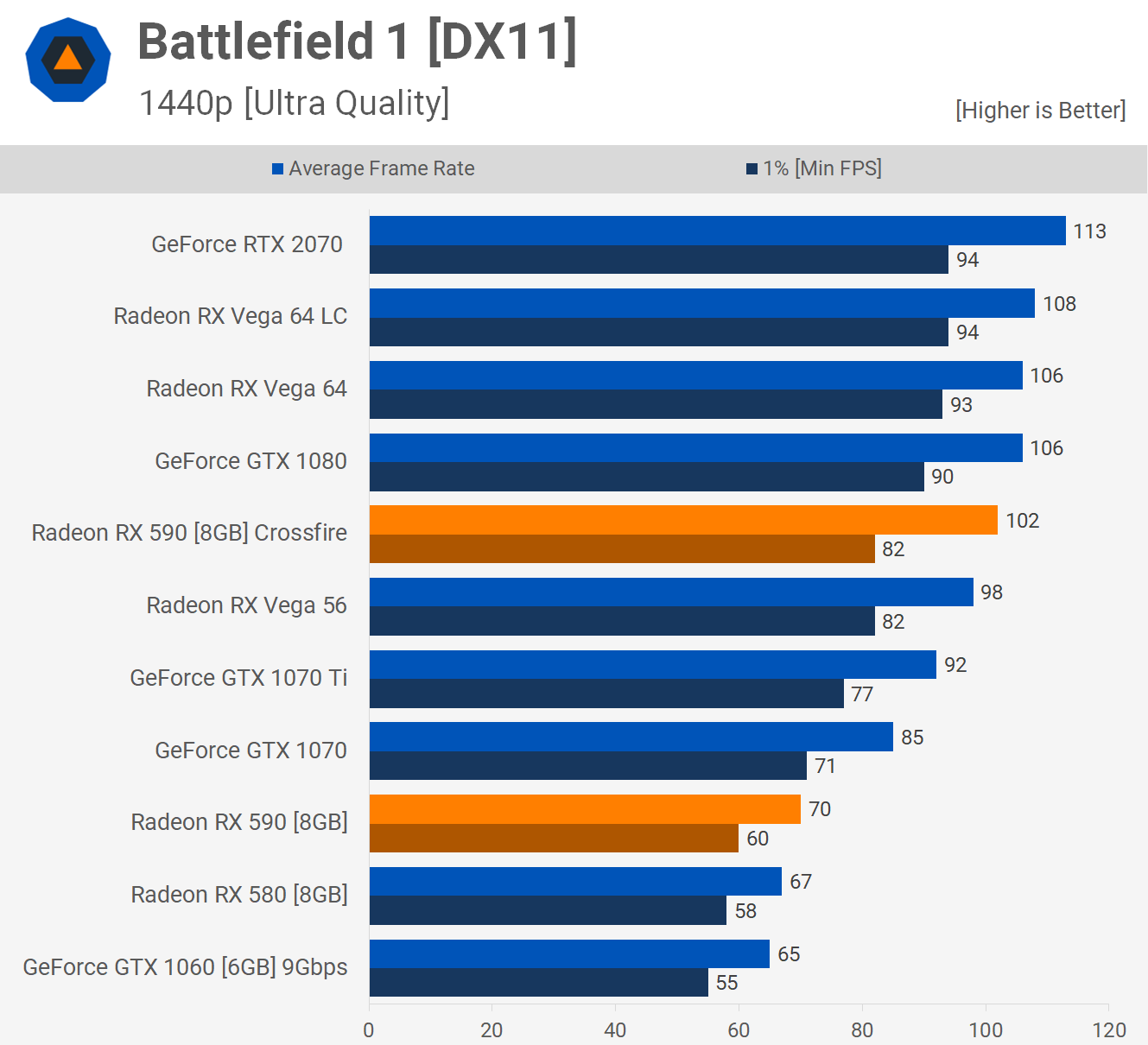
The best instance of Crossfire scaling that nosotros came across in this new batch of games was seen in Strange Brigade. Here the Crossfire RX 590s boosted the average frame rate by almost xc%... and ameliorate yet frame time performance was still very good.
And then at 1440p nosotros see over 90% scaling striking 94% so this is an infrequent result for the Crossfired 590s.
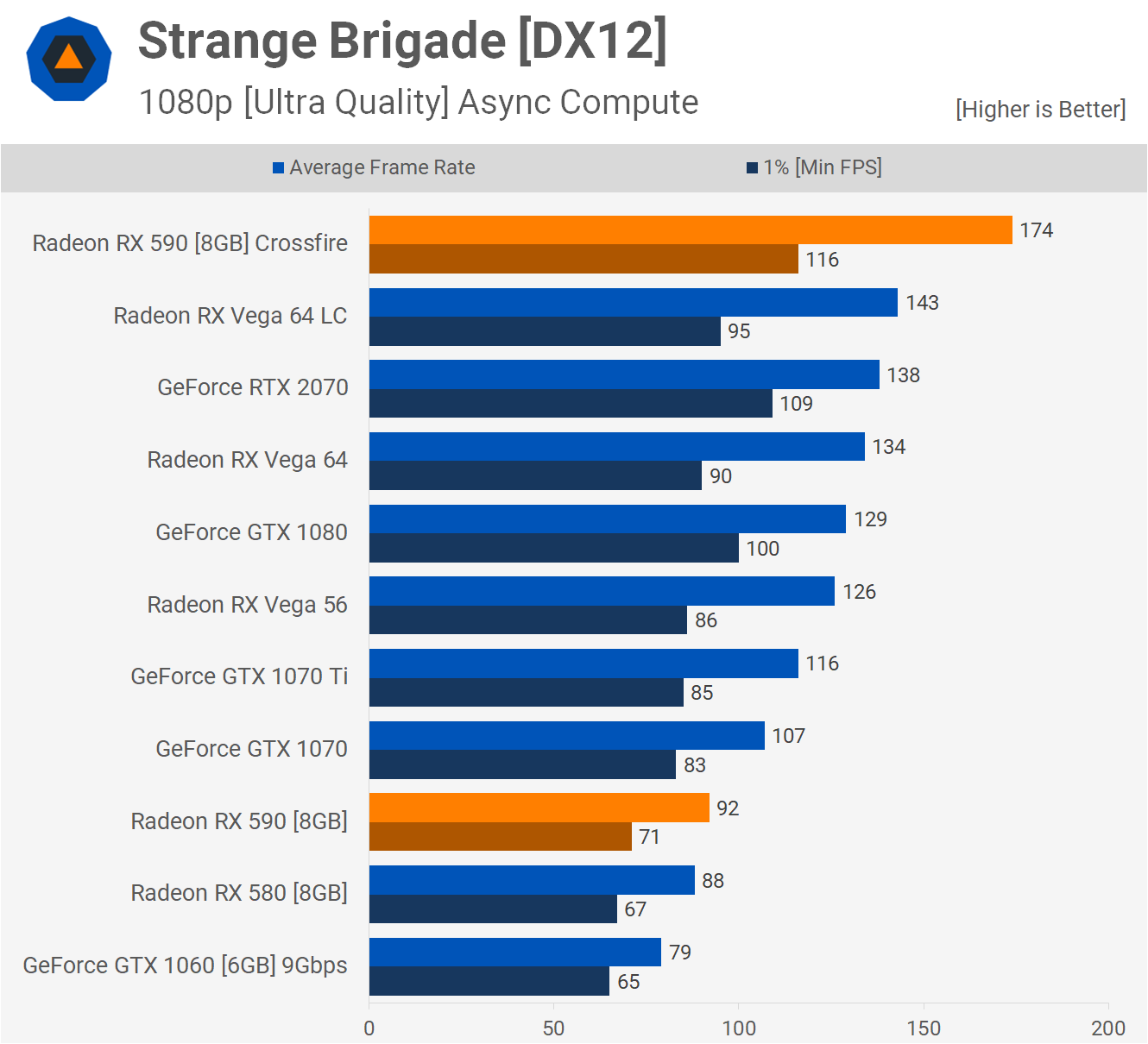
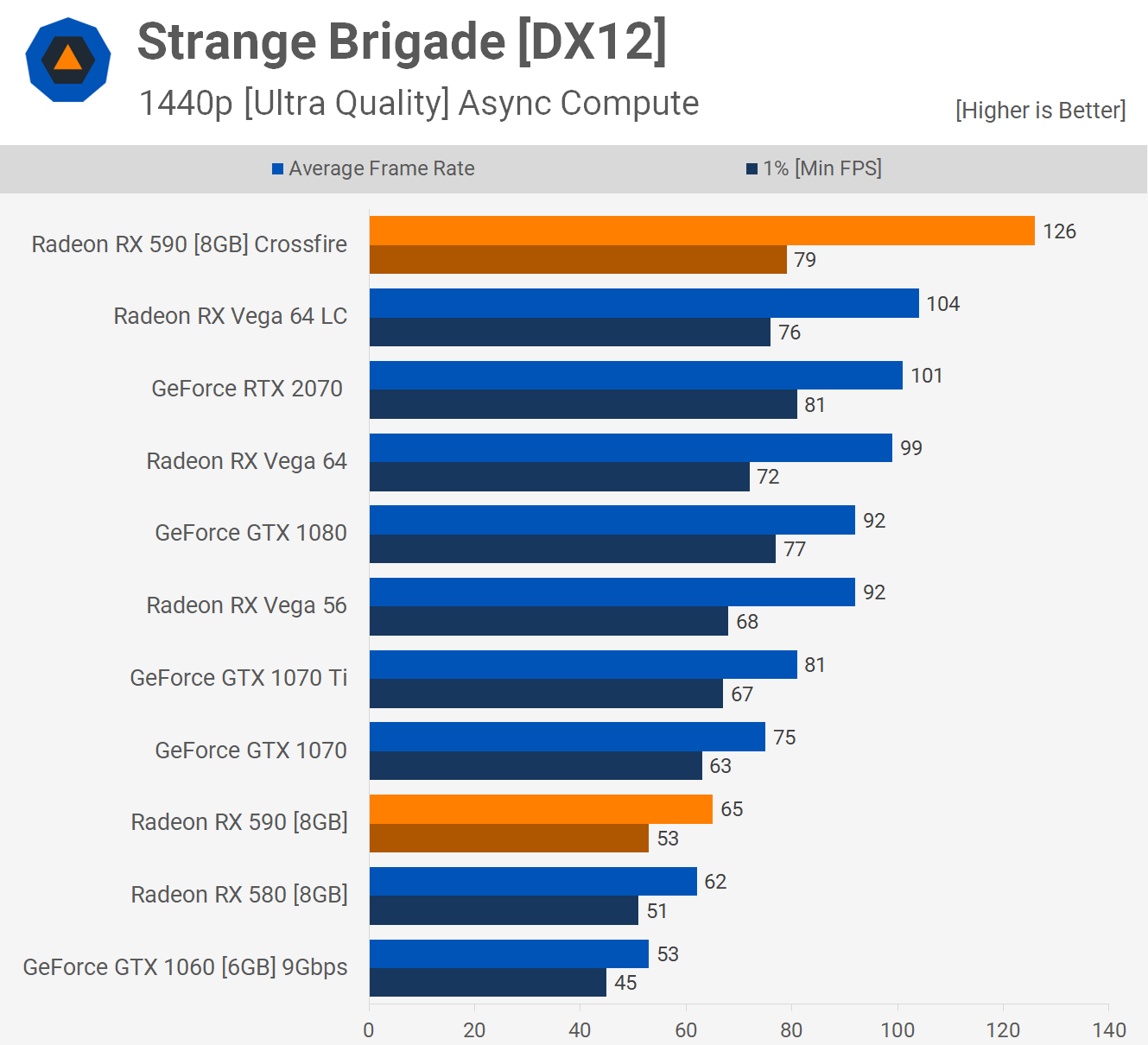

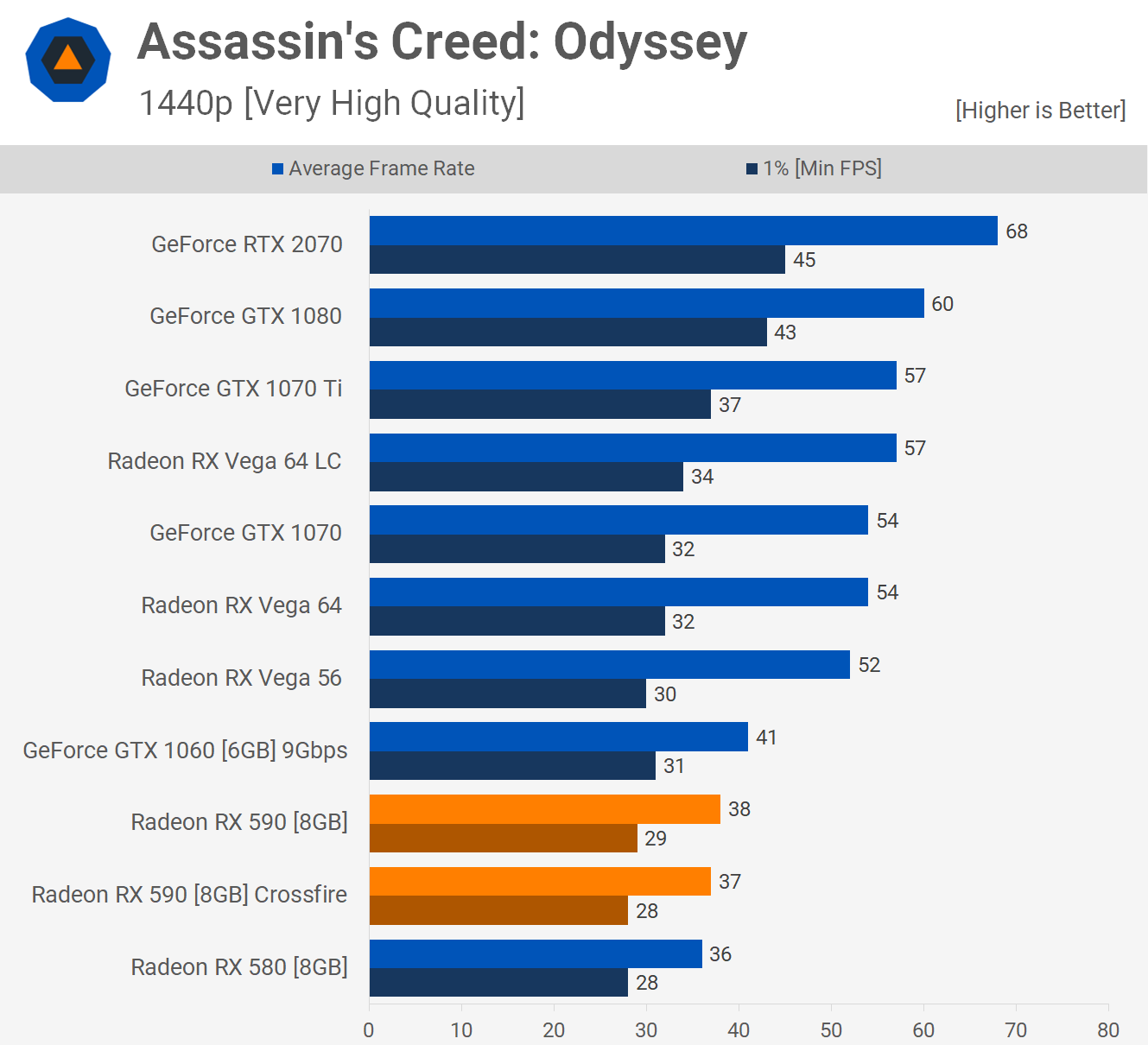
Radeon GPUs perform poorly in Assassinator's Creed Odyssey and then unsurprisingly Crossfire back up is non-existent in this title. Whereas the 590s were faster than the RTX 2070 in Foreign Brigade, hither they are 44% slower.
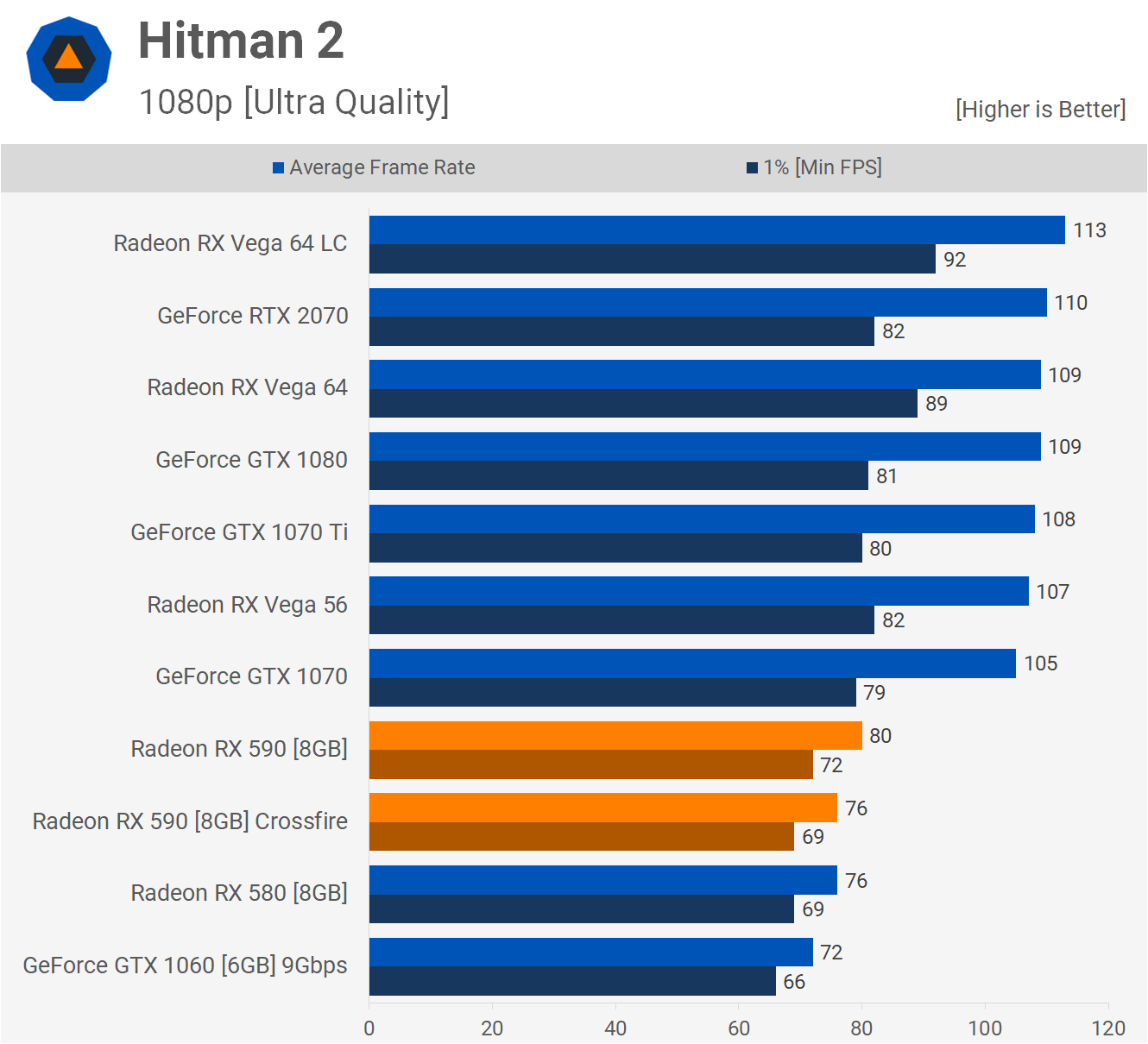
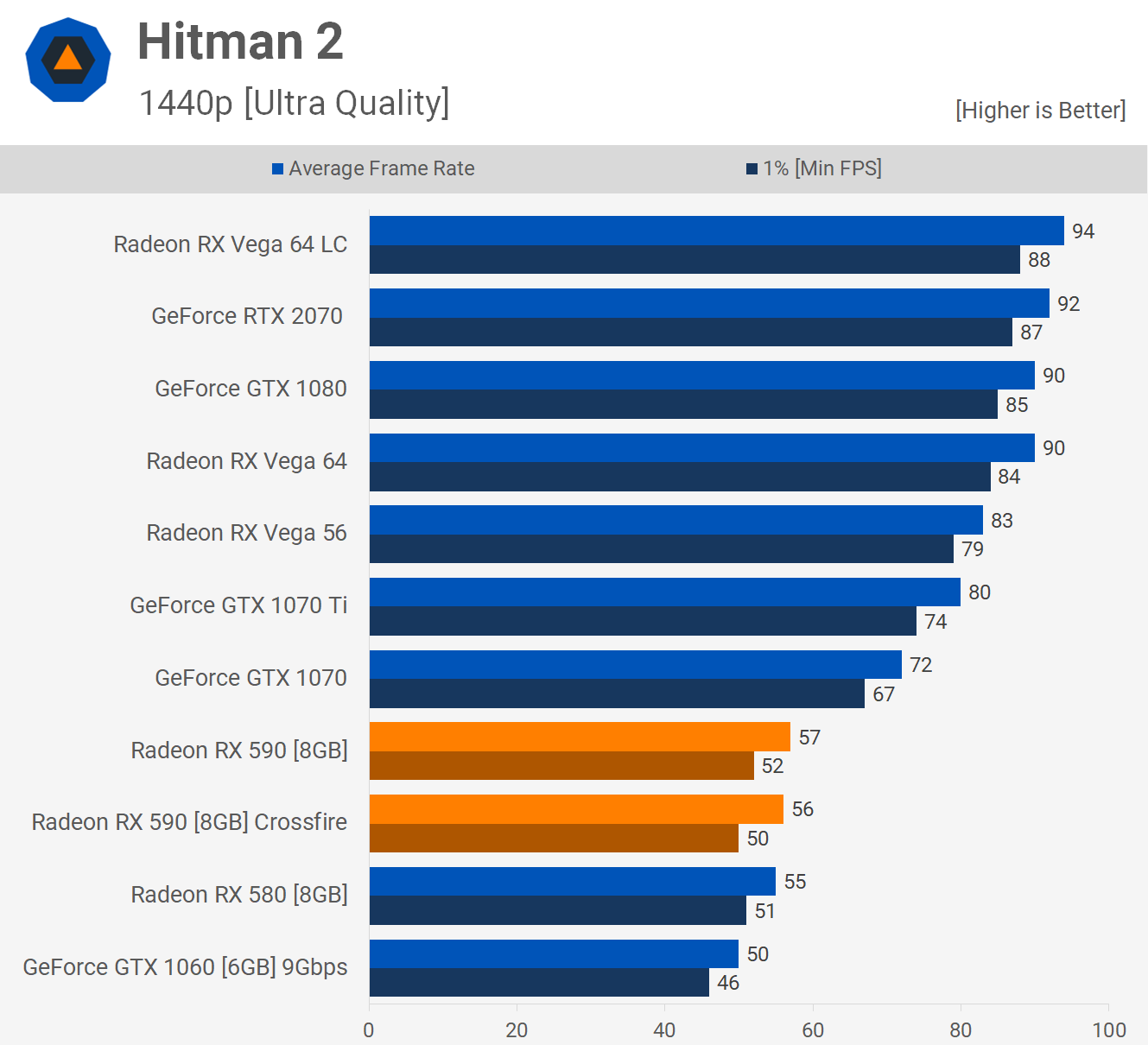
Moving on to Hitman 2, nonetheless another title that lacks Crossfire support and therefore running with the technology enabled actually slightly reduces performance. This is also seen at 1440p.
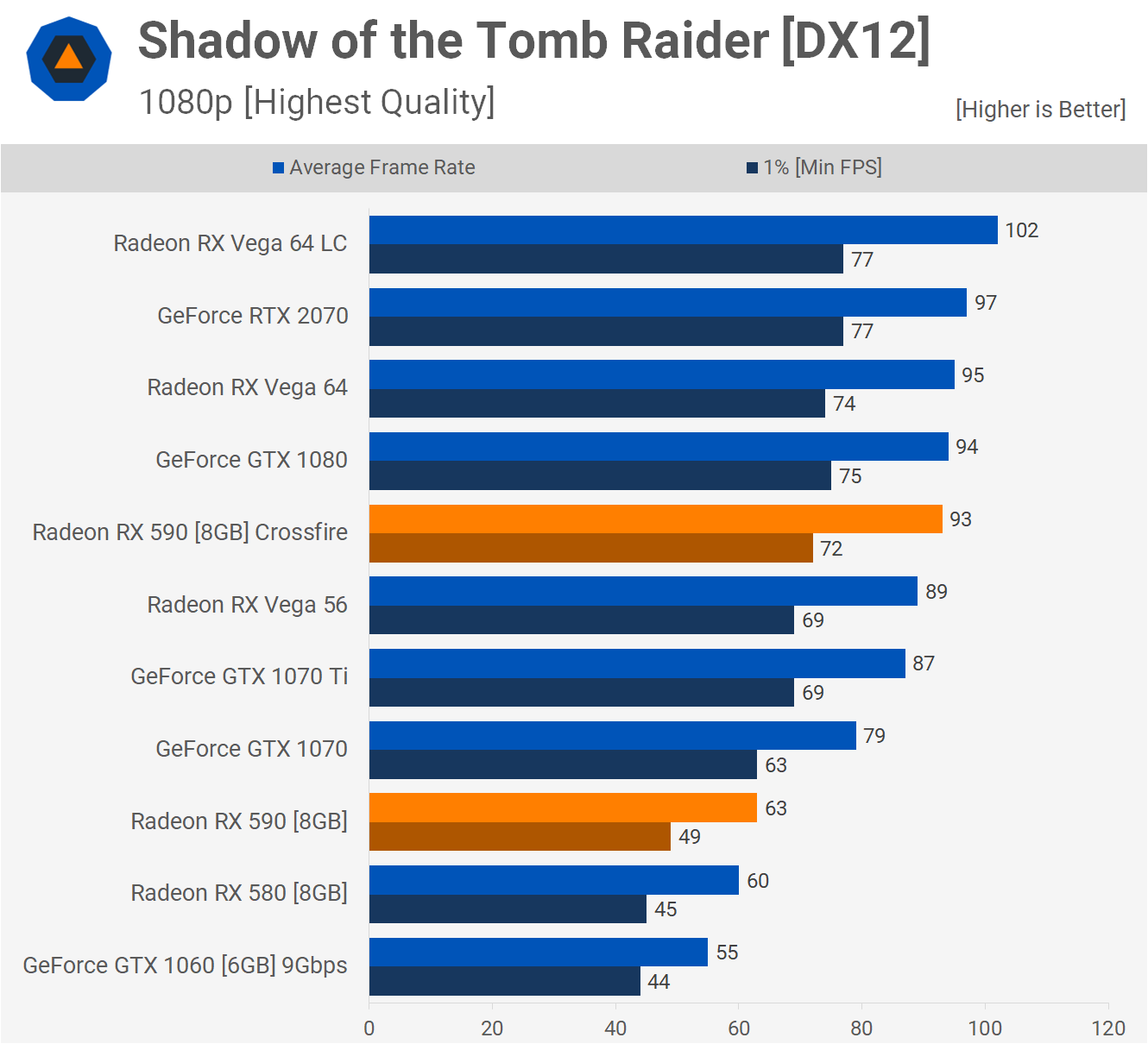

Shadow of the Tomb Raider gets usa a 48% operation boost at 1080p and this placed the RX 590s alongside the GTX 1080 and Vega 64. Scaling is dramatically improved at 1440p and at present we're seeing a 61% performance heave, this placed the 590s on par with the RTX 2070. A solid event for this game.

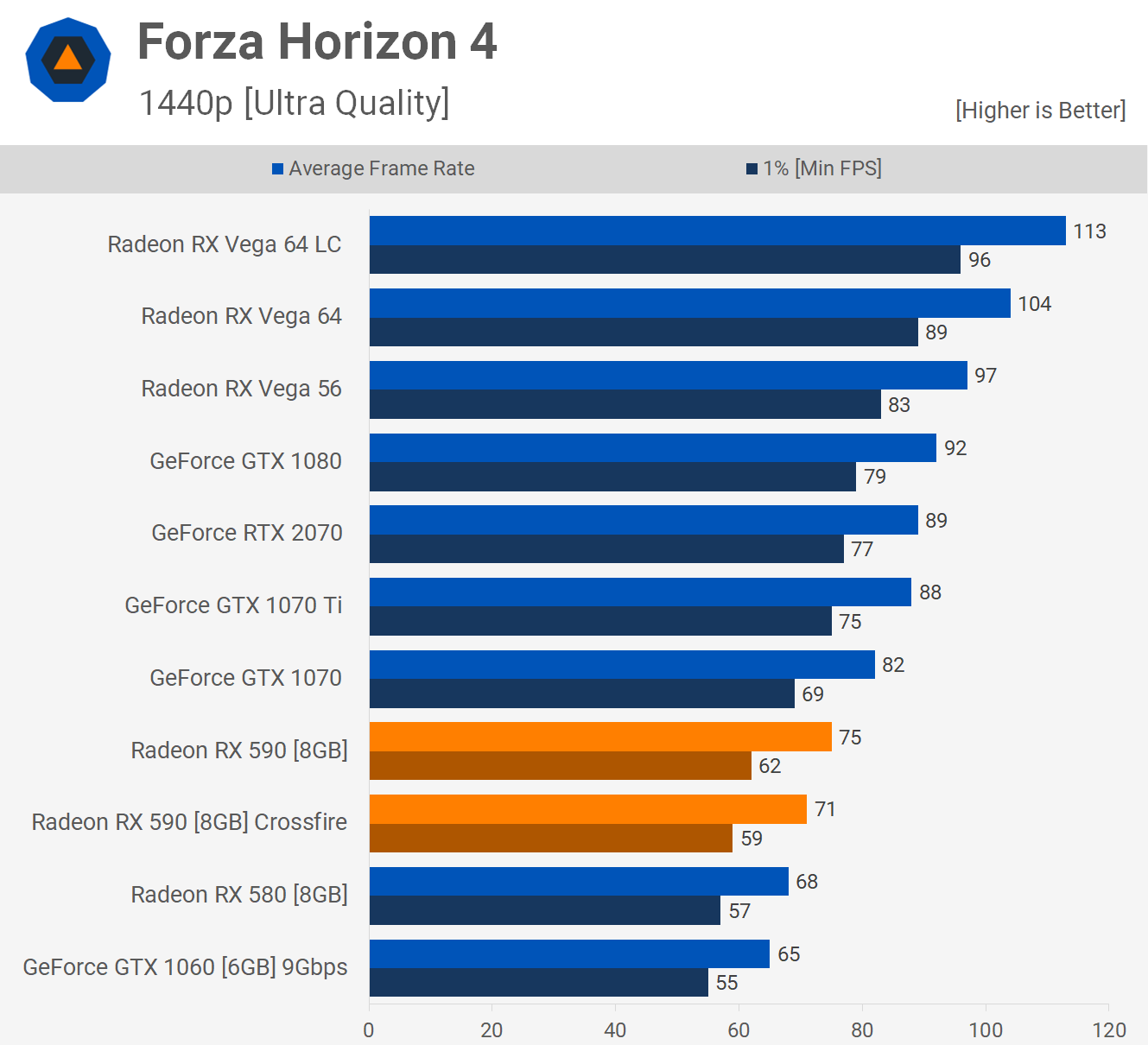
Forza Horizon iv is another title where Crossfire isn't supported and therefore we saw no gains at 1080p or 1440p. In fact, we saw a slight performance regression.
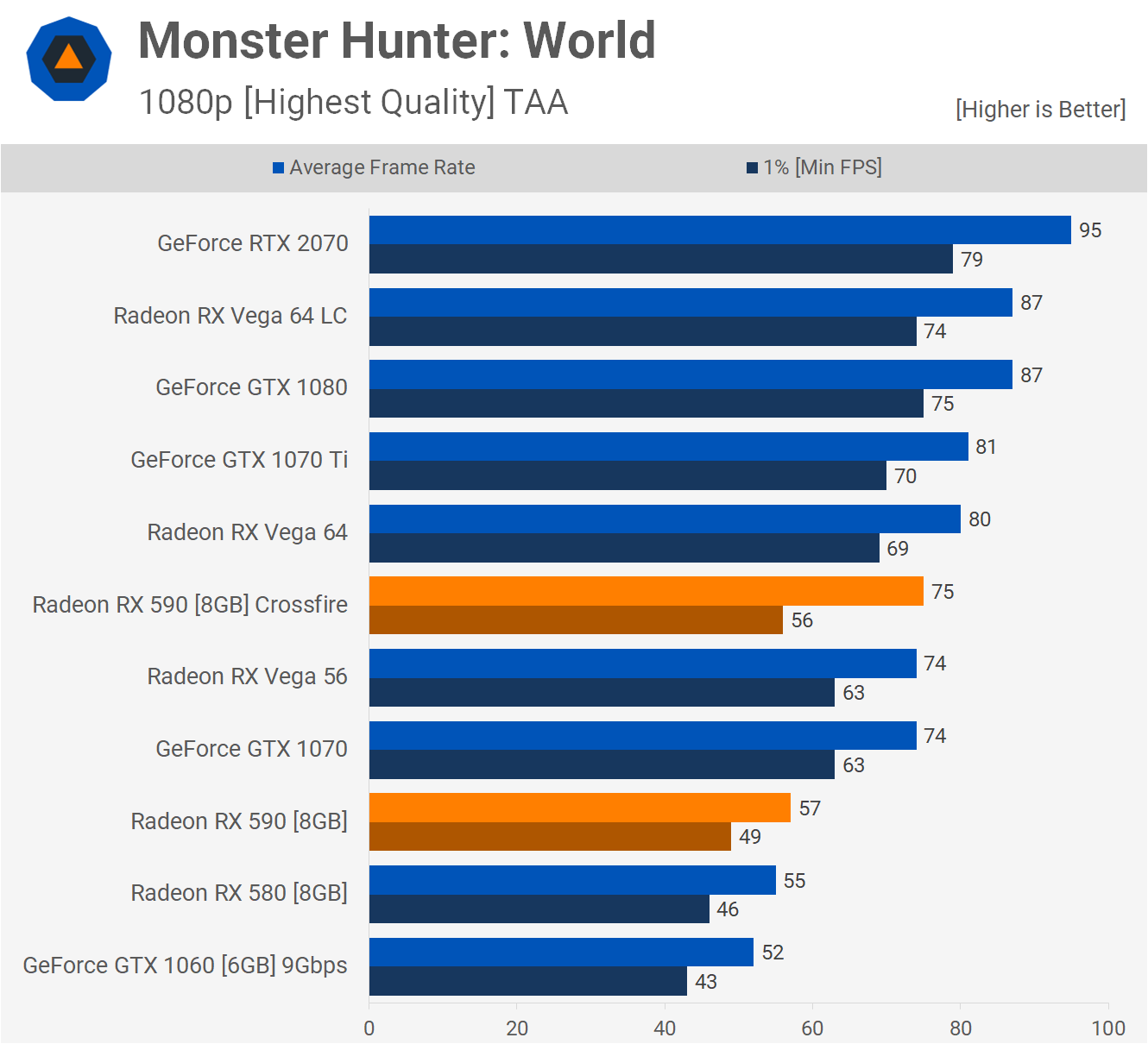
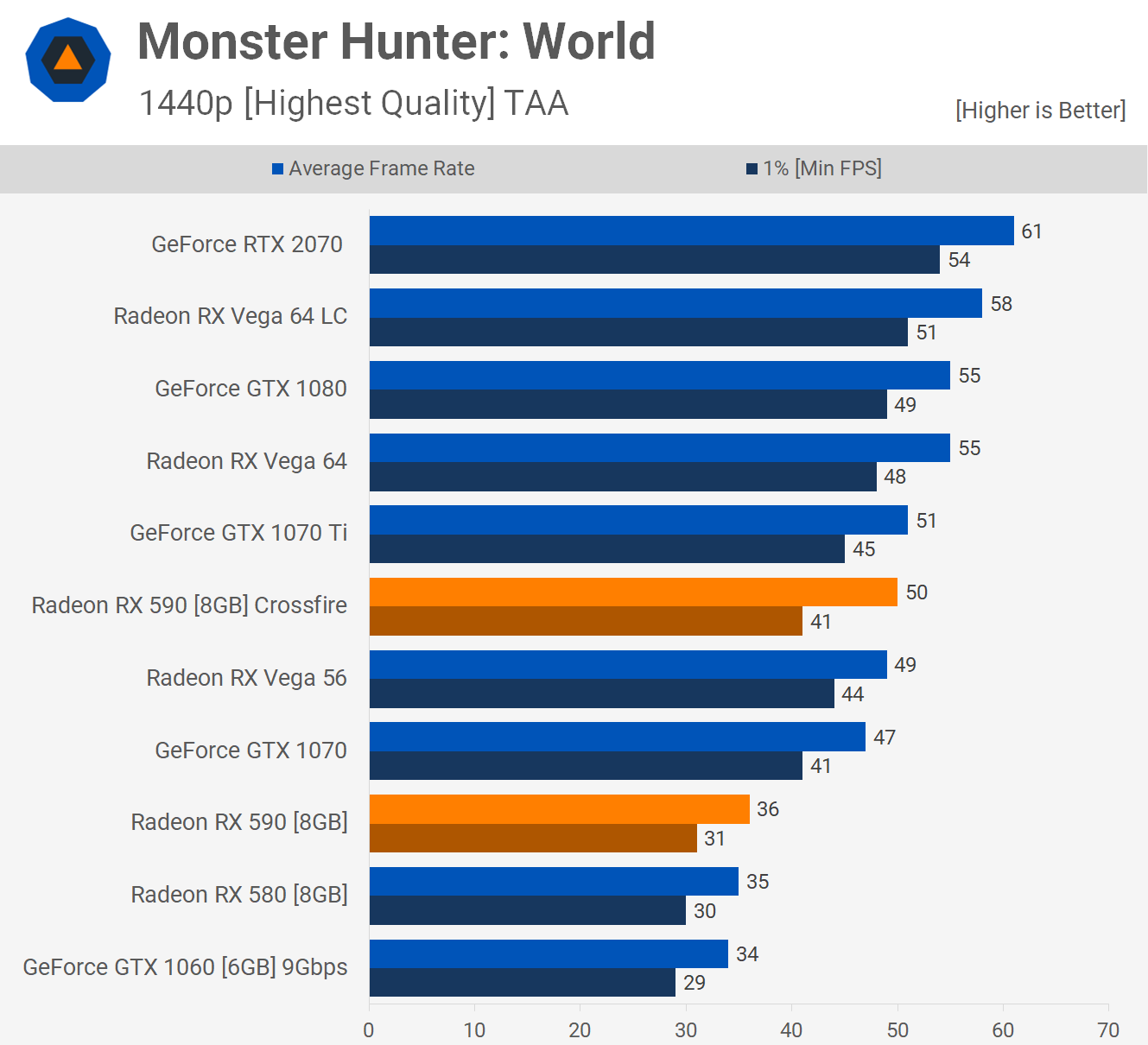
To my suprise Monster Hunter World did support Crossfire though the frame time performance at 1080p was a little sketchy. We saw a 32% boost for the average frame charge per unit, but only a 14% improvement in frame time operation.
Jumping up to 1440p helps ironing this result out, merely even then scaling is beneath 40% which is weak given the investment, hardly justifying a second graphics carte du jour.
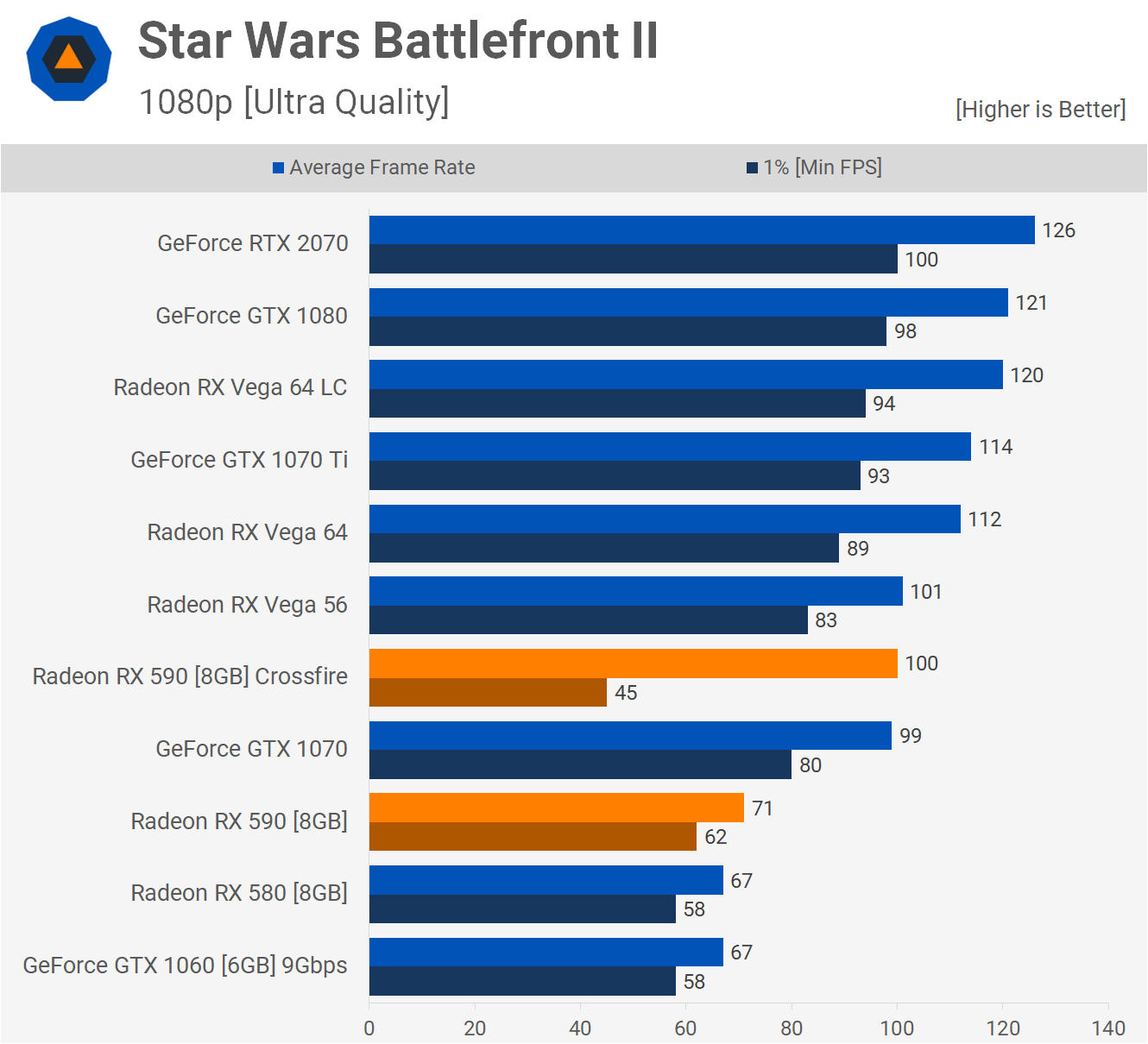

Hither we accept an example of a title that "looks expert" when focusing on the boilerplate frame rate, but the experience was really horrible. Despite averaging 100 fps in Star Wars Battlefront Ii at 1080p, the frame time performance was shocking, dropping down well below the result of a single 590. The game was basically unplayable and buggy with Crossfire enabled and in this instances a constant thirty fps provides a nicer gameplay experience.
The frame time outcome persisted at 1440p. We didn't go far in researching a fix, but out of the box Crossfire does not work and thus you're better off with a unmarried RX 590 in this title.
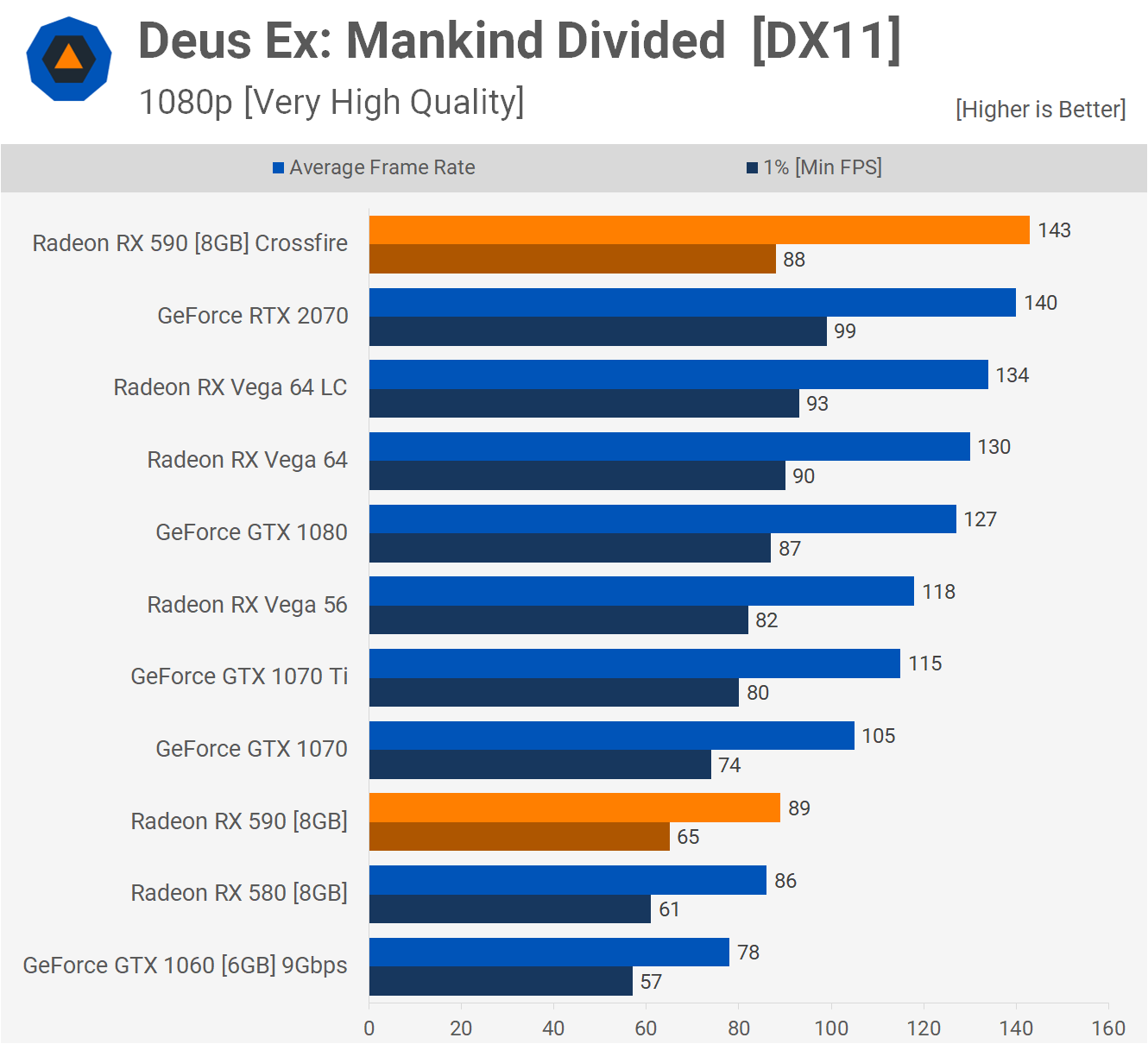
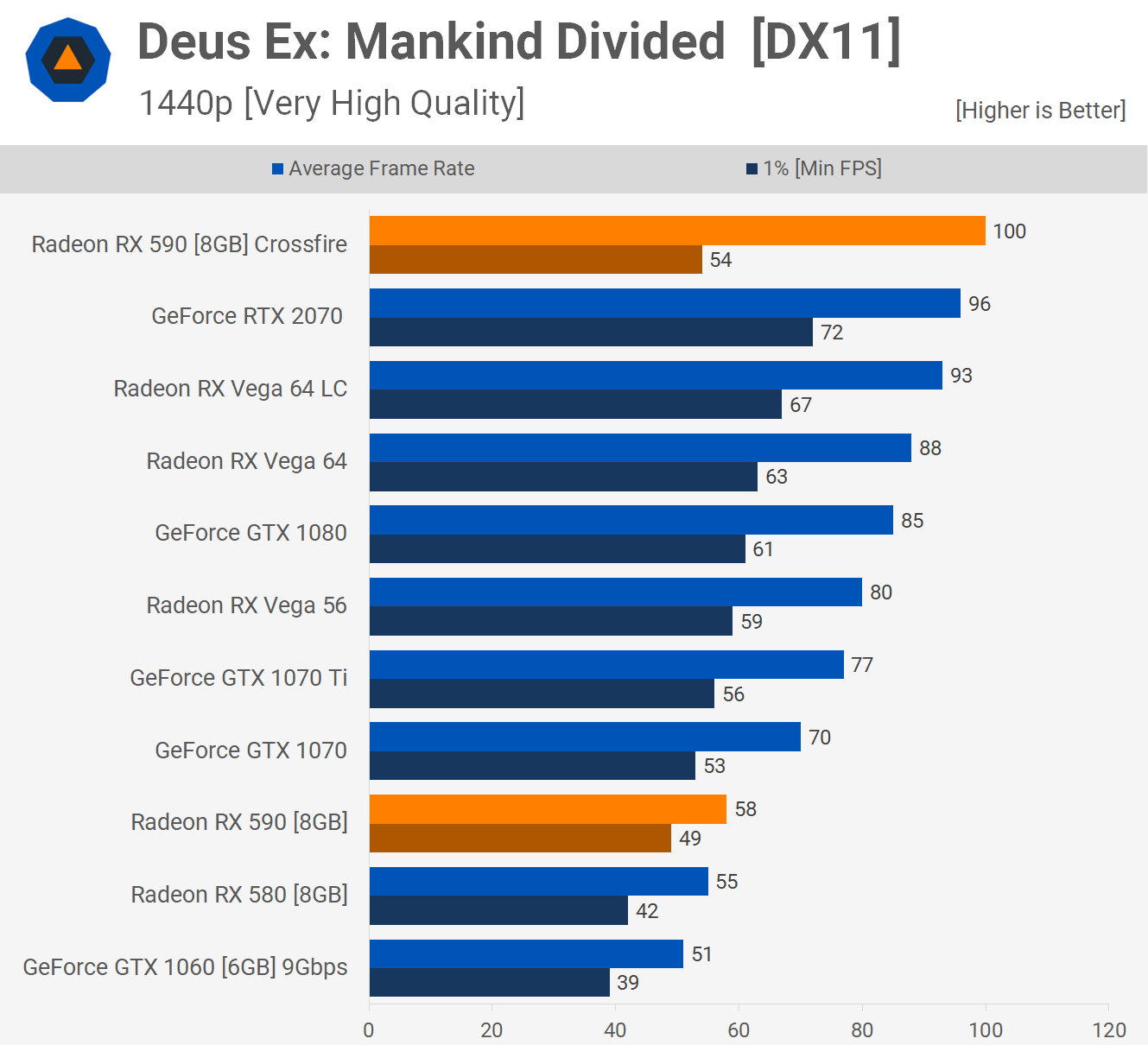
Frame time performance was likewise a niggling sketchy in Deus Ex Mankind Divided, though nowhere near as bad as what nosotros saw in Battlefront Ii. The issue was a piffling more noticeable at 1440p and although the average frame rate is much improved with a 2d 590, the overall feel wasn't and due to the disparity between the boilerplate and 1% low result when using Crossfire, we'd rather play this title with a single 590.
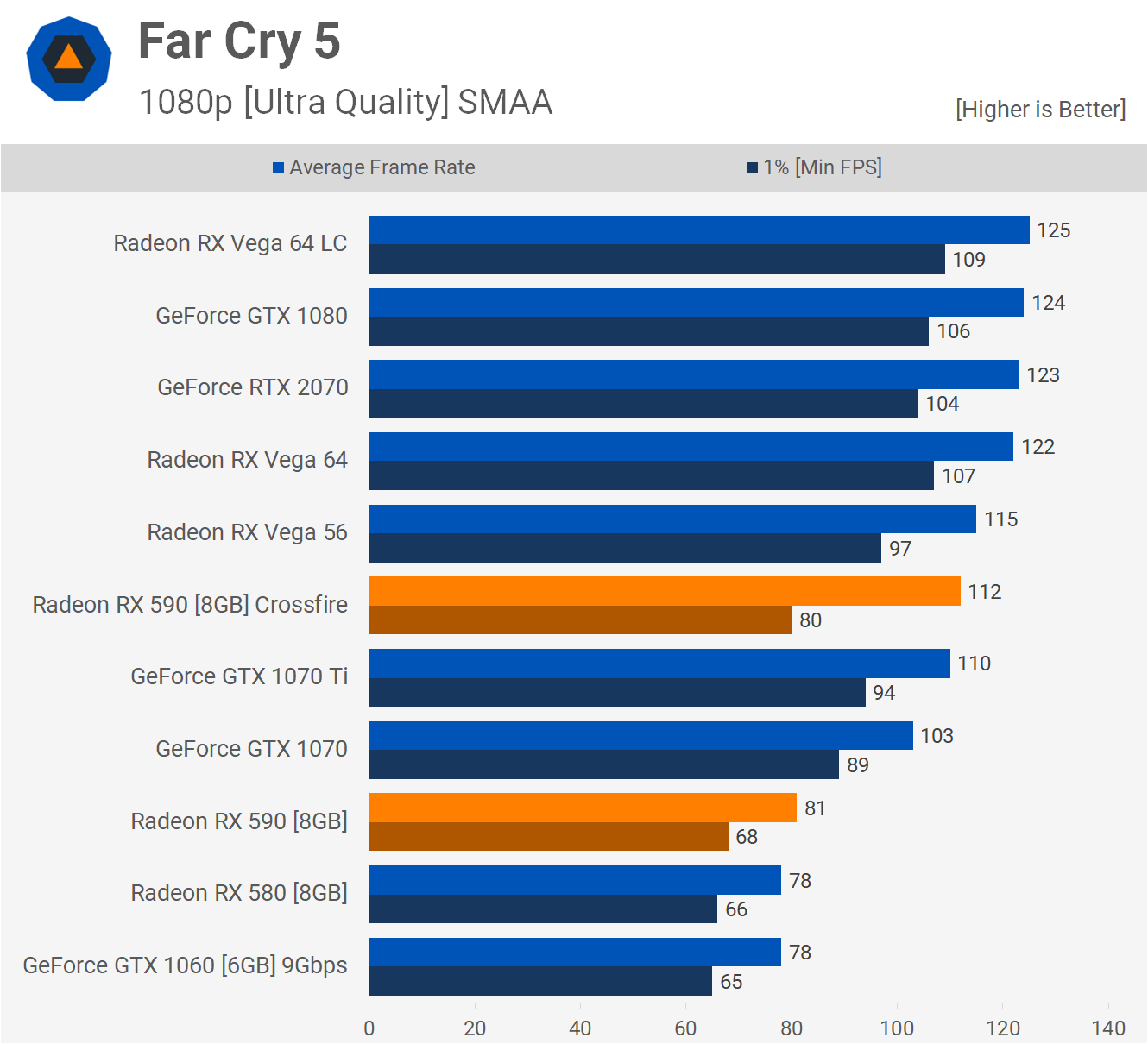
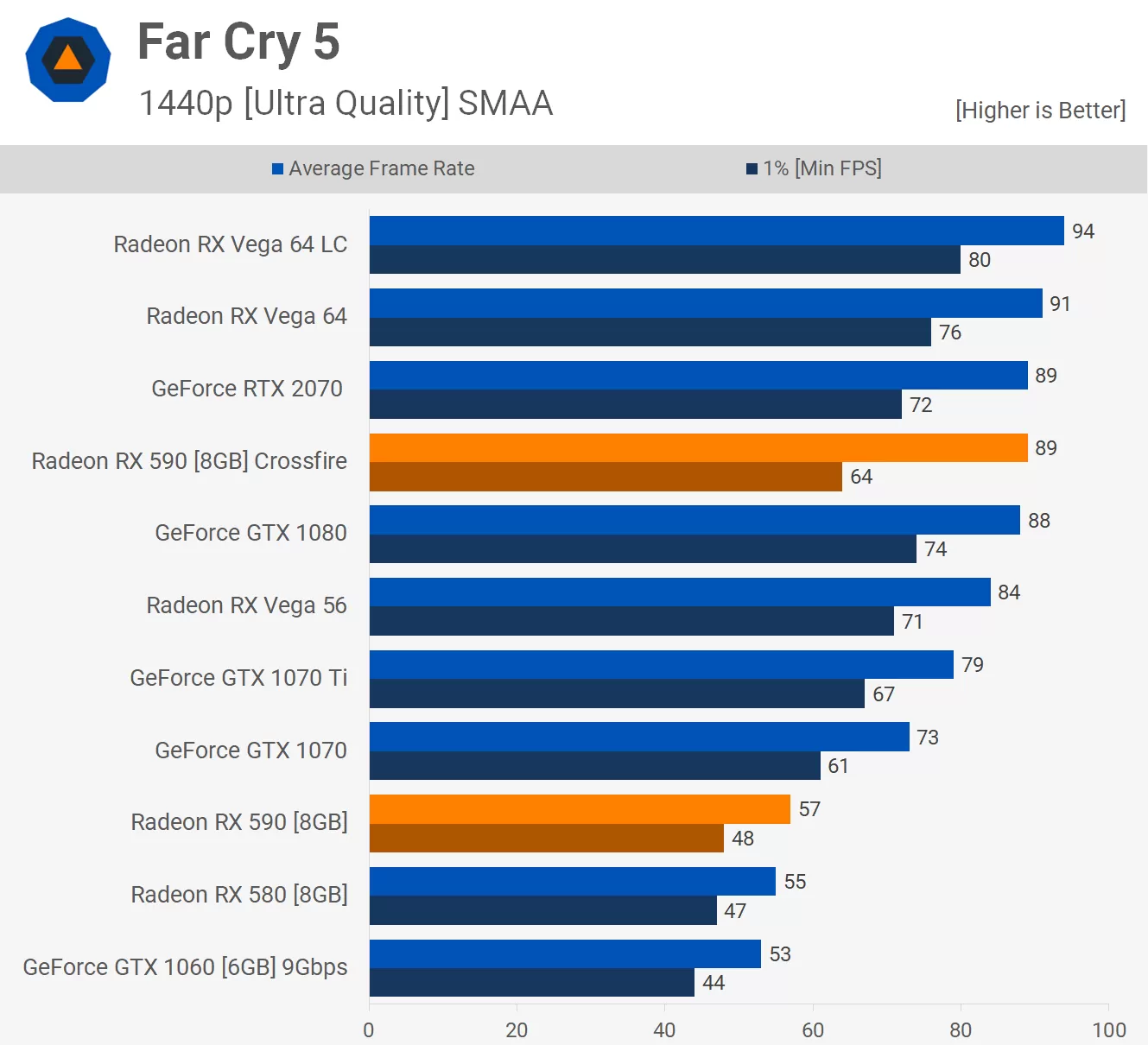
There was likewise a little bit of stuttering going on in Far Cry 5 and this was present at both 1080p and 1440p.
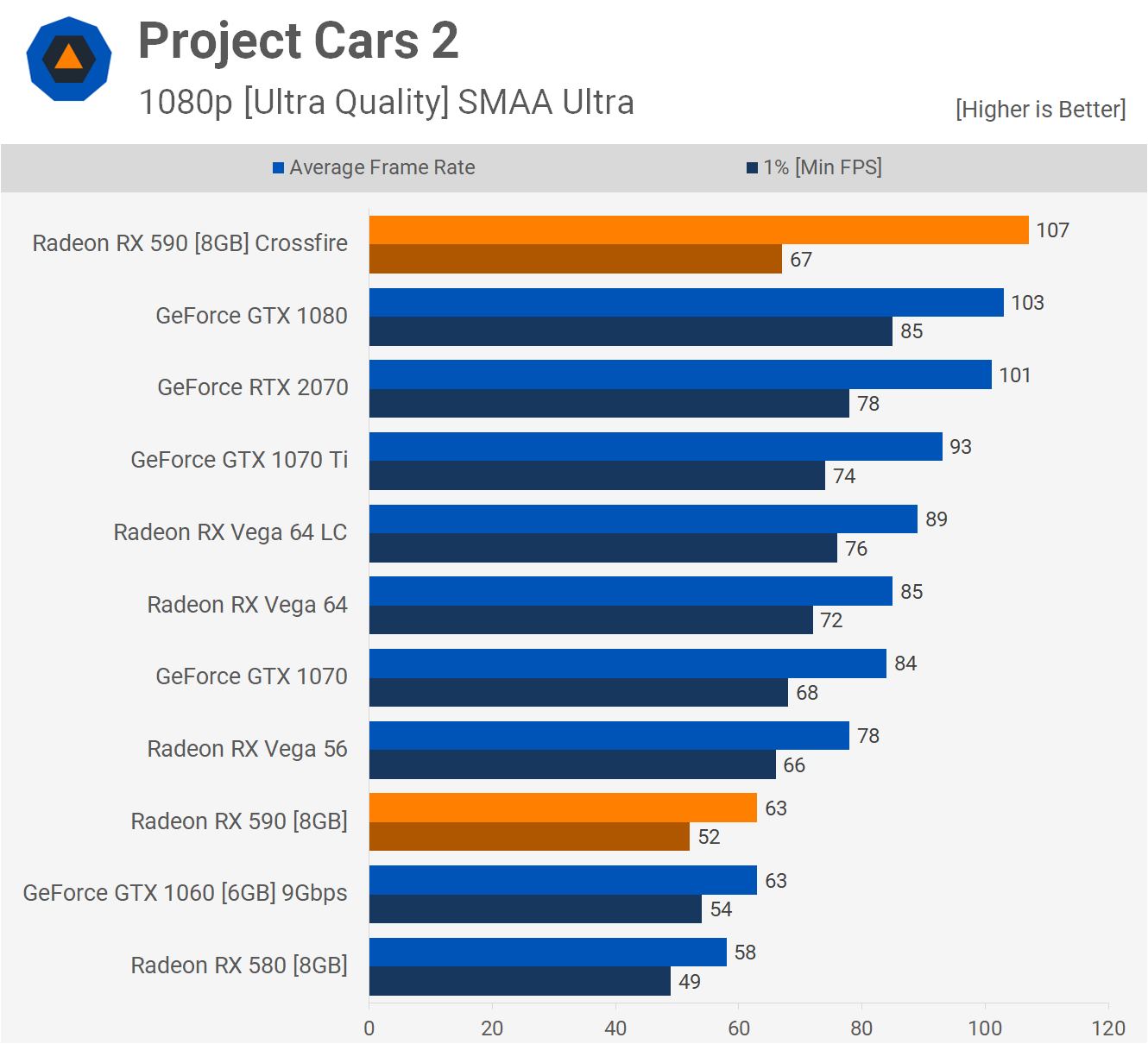
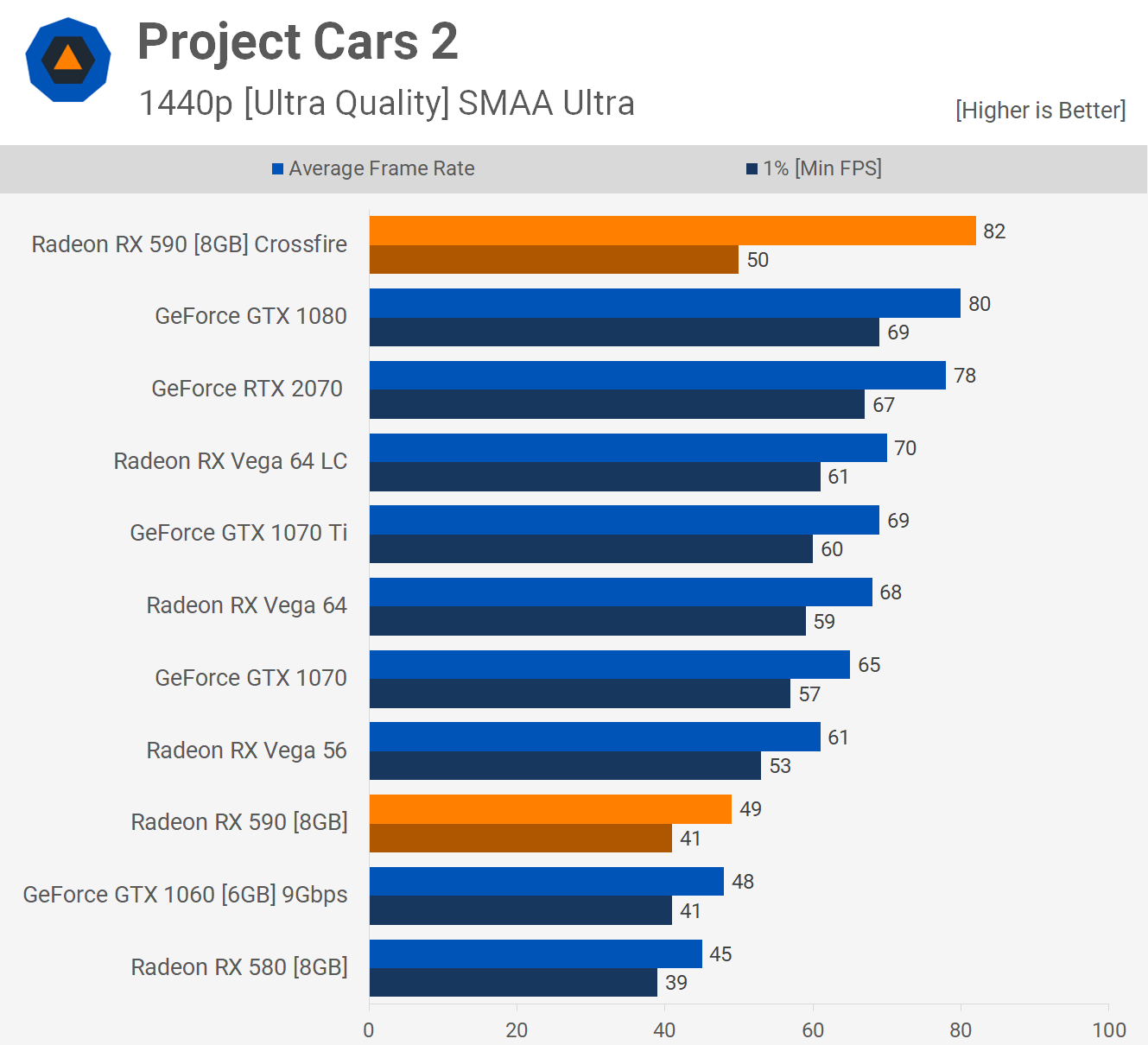
Projection Cars 2 was another championship where we saw operation gains, just the frame fourth dimension functioning wasn't great and much worse than that of college end single GPU graphics cards.
Power Consumption
All graphics card configurations with the exception of the Crossfire cards were tested in Crysis 3 to measure ability consumption. Yet Crossfire doesn't work in Crysis 3, so we used F1 2022 as it was one of the better games for scaling. Typically you're looking at a total organization power increase of around sixty% when using a second RX 590 and that leads to a pretty cruel consumption effigy.
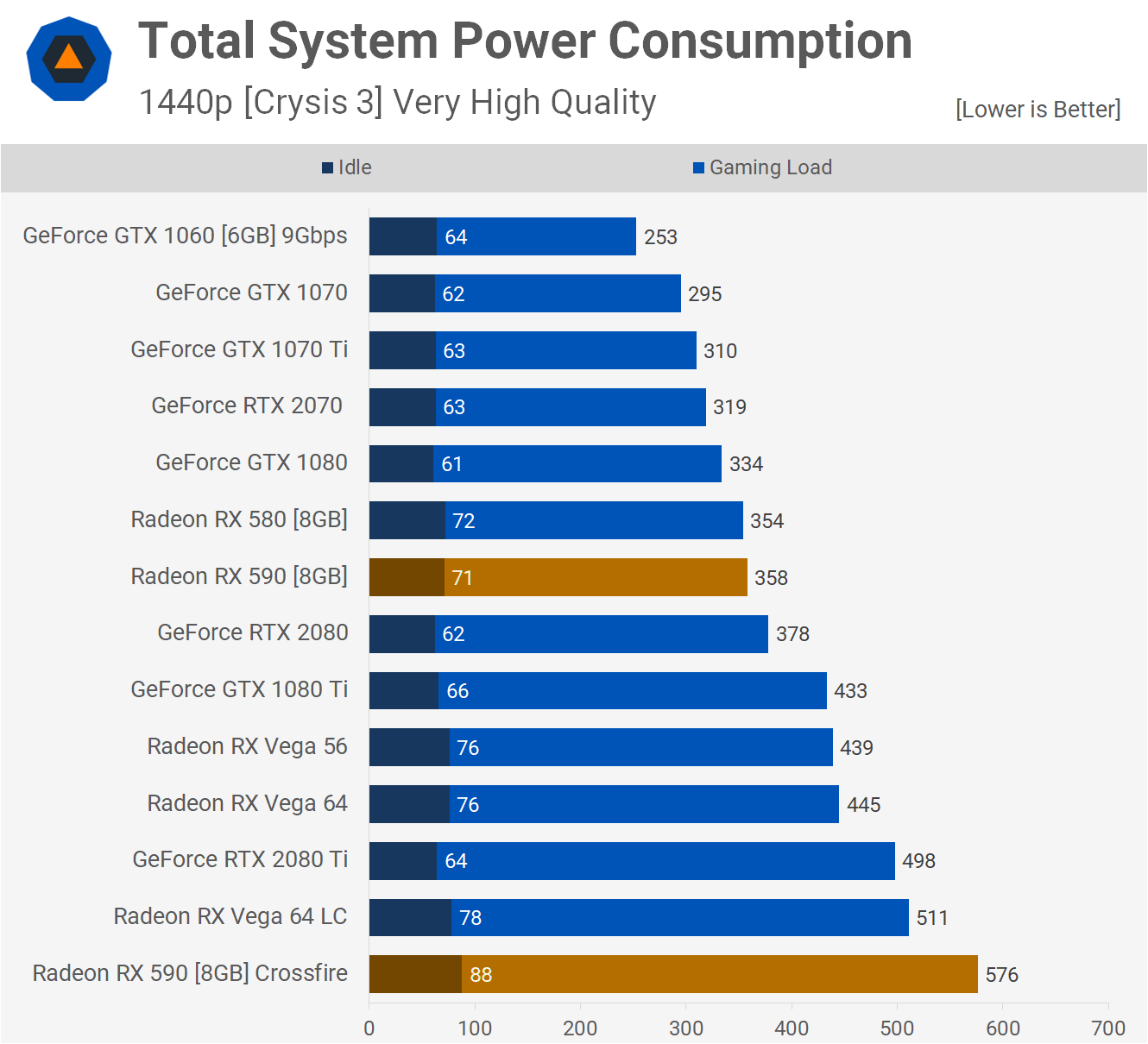
Here the Crossfire 590'due south pushed total system draw to 576 watts and I did observe merely over 600 watts in Strange Brigade. This is quite a bit more than fifty-fifty a Vega 64 Liquid graphics carte du jour and almost twice that of a unmarried RTX 2070, and so pretty horrible stuff when information technology comes to power consumption.
Putting It All Together
When compared to a single RX 590 we saw a 37% boost to boilerplate frame rates at 1440p, but (and this is a big but) that effigy alone is misleading. Frame time performance in Star Wars Battlefront II and Deus Ex Mankind Divided was so bad that I preferred to play with a single carte du jour. Stuttering was as well an issue in Far Cry 5, Project Cars ii and The Witcher three.
Commonly I also test with Clay 4 but that title suffered serious graphical glitches with Crossfire enabled so I had to drop it from the batch of games tested.

So are you meliorate off buying a faster single GPU graphics card or ii cheaper graphics cards?
If y'all haven't worked that one out yet, here is your reply: The RTX 2070 costs $500 while two RX 590s will be a little more that at $280 each. Even if y'all compared the RTX GPU to a pair of $200 RX 580s the upshot would be much the aforementioned. Get the more expensive higher-terminate graphics card.
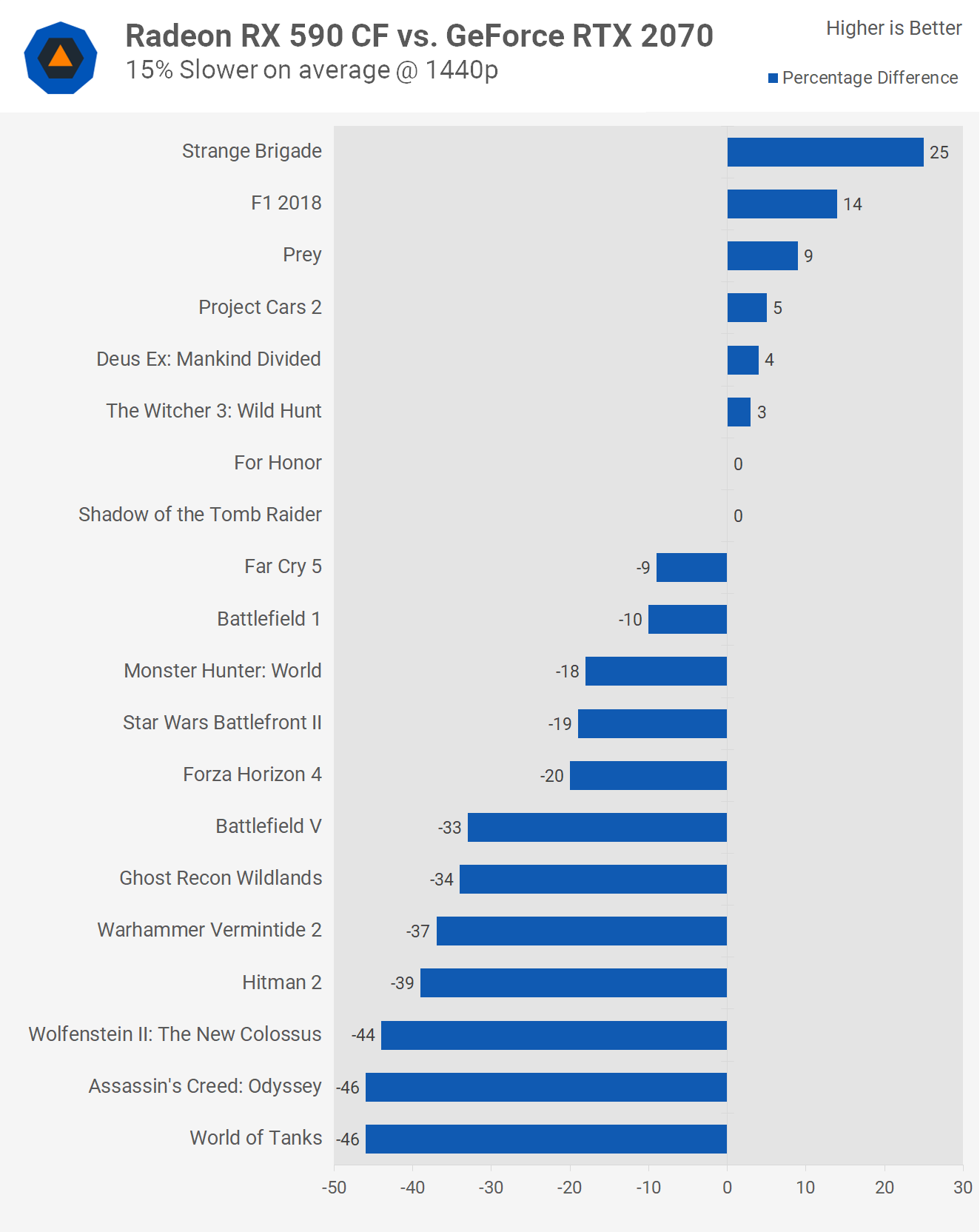
When everything is going right for the multi-GPU plan, the RX 590's killed it, chirapsia the RTX 2070 by a whopping 25% margin. Simply out of the 20 games tested, we saw that kind of margin only once. The side by side best was a 14% win in F1 2022, 9% in Casualty, 5% in Project Cars ii but frame time functioning was poor, as was in Deux Ex and The Witcher iii.
Closing Remarks
Three years after we observe that one time again multi-GPU engineering science seems like a adept idea on paper, only in practice it's a bit of a fail. In our stance SLI/Crossfire only makes sense for those with money to burn down. For example, right now RTX 2080 Ti SLI graphics cards are nigh the only multi-GPU configuration that makes sense. If you're at the end of the road and there is zilch faster, yet you want more and can spend the big bucks, yous can go a second RTX 2080 Ti.
But it doesn't brand sense to run RTX 2080 SLI cards, for case. Merely get a single RTX 2080 Ti and yous'll receive smoother performance in the vast majority of titles.
Equally for the RX 590s in Crossfire, nosotros'd much rather have a single Vega 64 graphics card. It'southward extremely rare that two 590s volition provide higher frame rates than a single Vega 64, while also offering stutter-free gaming.
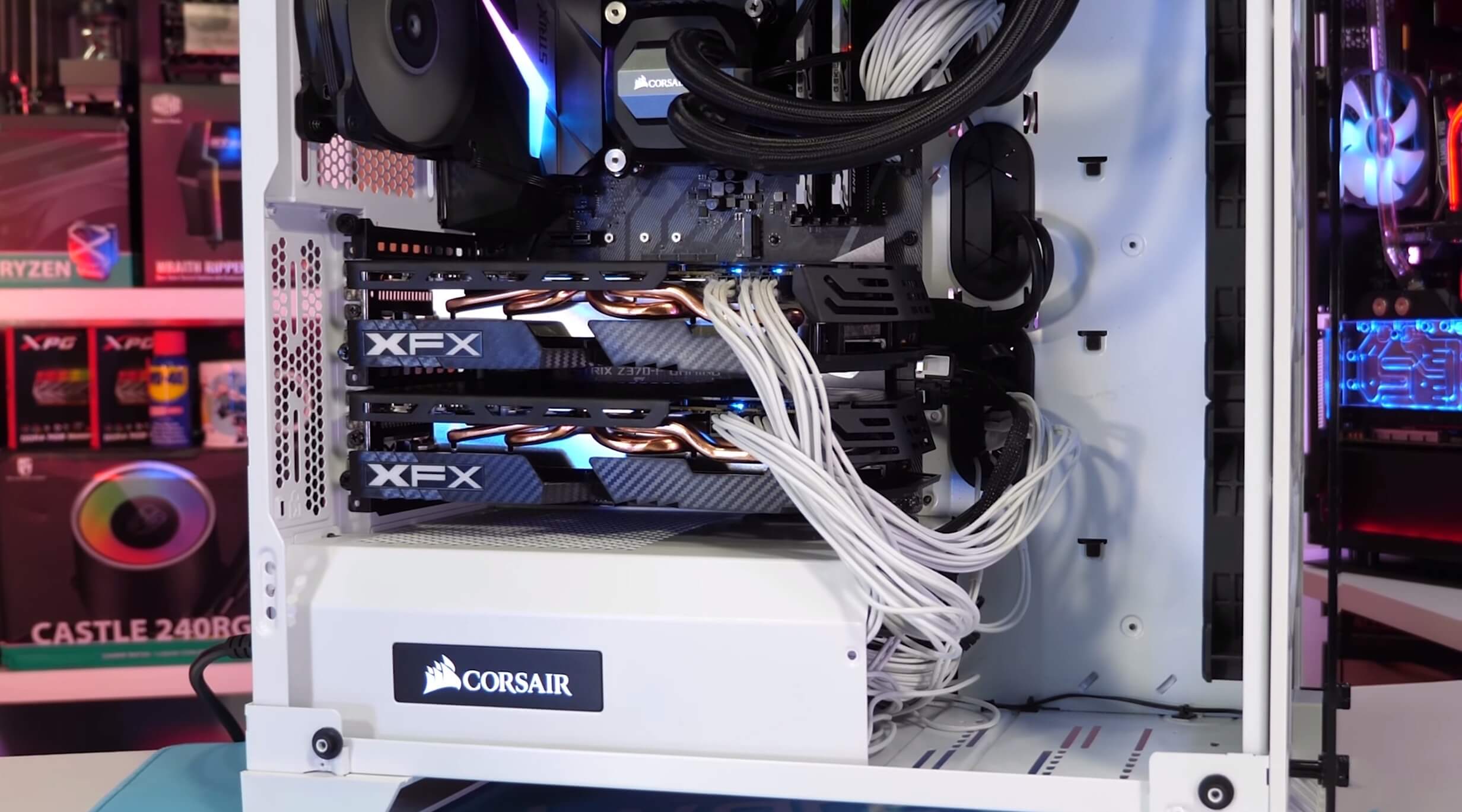
If yous're only always going to play a game similar F1 2022 that supports Crossfire actually well, then getting two RX 570s for $300 volition be a difficult combo to beat. Merely who buys a graphics card to only ever play 1 or two games?
Other drawbacks that are as well part of this conversation include rut and power consumption. Those two RX 590s were dumping so much heat into the Corsair Crystal 570X case that you could justify spending more coin in example fans and even then you'll still exist running hotter due to the way the cards are stacked. You'll as well lose out on the power supply. The RTX 2070 works without an issue with a 500w unit, and 600w would be more than than enough. The Crossfire 590s though will need an 800 watt unit, 750w would be the minimum.
Ultimately, it'due south the poor software support that kills these multi-GPU setups and it'due south why we experience no one should burden themselves with SLI or Crossfire today.
Shopping Shortcuts:
- GeForce GTX 1070 Ti on Amazon, Newegg
- Radeon RX 570 on Amazon, Newegg
- Radeon RX 580 on Amazon, Newegg
- Radeon RX 590 on Amazon, Newegg
- GeForce GTX 1060 6GB on Amazon
- GeForce GTX 1080 on Amazon, Newegg
- GeForce RTX 2080 Ti on Amazon, Newegg
- GeForce RTX 2080 on Amazon, Newegg
- GeForce RTX 2070 on Amazon, Newegg
Source: https://www.techspot.com/review/1763-radeon-rx-590-crossfire/
Posted by: laperlewoliftell.blogspot.com


0 Response to "AMD Radeon RX 590 Crossfire and the State of Multi-GPU Technology"
Post a Comment